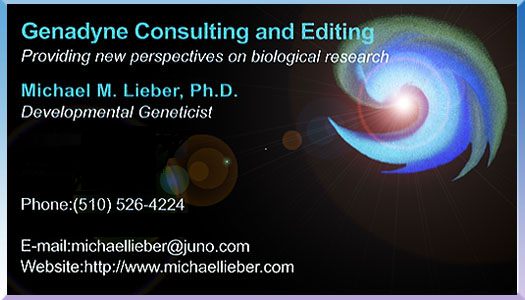|

|
|
Mutation, Development and
Evolution
During my tenure as a graduate student, “Mutation,
Development and
Evolution” was submitted in May, 1967 as a thesis to the Institute of
Animal Genetics, University of Edinburgh. This thesis (Lieber, 1967, DOWNLOAD PDF FILE) anticipated many of the subsequent
developments in genetics. At the time, it explored the possibility that
cellular processes can convert various chemicals into mutagens, thereby
internally increasing the mutation rate in genes, a phenomenon later
demonstrated by research and deemed very relevant to the issue of
environmental chemicals as a source of mutagenesis and carcinogenesis.
The thesis also conjectured that gene boundaries were not absolute but
changeable, and this has been shown to be the case through research in
molecular genetics. Hypothetical, controlled sequence-changes in M-RNA
after transcription was also illustrated, with described implications
for gene expression and development, and various examples of this
process, such as intron deletion from post-transcriptional M-RNA, have
been repeatedly demonstrated through experiment. Furthermore, some
enzymes, referred to as genezymes in the thesis, were conjectured as
behaving as genes. The discovery of prions would seem to give some
evidence of this.
In a concluding section, the thesis proposed a modern version of the
pangenesis concept, whereby M-RNA molecules can transmit, via the blood
stream, copies of mutant somatic genes into the cells of the germ line,
become reversed transcribed into DNA copies, and these DNA copies
eventually being incorporated into the genomes of the germ line cells.
As pointed out in the thesis, this would enable the eventual
transmission of somatic mutations to progeny. (See page 52 of the
thesis.) This view was presented three years before Temin and Baltimore
demonstrated the reverse transcription of M-RNA into DNA. In 1980,
Gorczynski and
Steele proposed a similar process of modern pangenesis to explain how
mutant, somatic antigen genes, conferring immune tolerance in mice, had
become demonstratedly transmitted to progeny through their experiments.
The thesis presented and illustrated a unifying view that mutagenesis,
far from being a random process, can be a highly directed and ordered
process within the organism. Being so, it was further postulated that
such inner controlled mutation could have provided evolution with a
significant inner-parameter, illustrating an inner determination of
evolutionary change, as opposed to a strictly selectionist
determination of such change.
The thesis was read by C.H. Waddington and Charlotte Auerbach, who was
my mentor, and the discoverer of chemically induced mutagenesis. The
written corrections and comments in the thesis are hers.
References
Lieber, M. M. (1967). Mutation, Development and Evolution.
DOWNLOAD PDF FILE
Gorczynski, R. and Steele, E. (1980).
Inheritance of acquired immunological tolerance to foreign
histocompatibility antigens in mice, Proc. Natl. Acad. Sci. USA Vol. 77
No. 5, pp. 2871-2875.
Research described in
various genetics textbooks.
home articles bio

Plant
Genomics & Developmental Biology Consultant / Expert Offering
Creative
Paradigms for Scientific Advancement in Agriculture and Medicine, with
Emphasis
on Plant Genetics / Genetic Engineering and Developmental Biology,
e.g.,
Organogenesis. Michael
M. Lieber, Ph.D. Berkeley, CA (510)
526-4224
MichaelLieber.com/Mutation-Development-and-Evolution.htm
(c) Michael M.
Lieber, Genadyne Consulting
E-Mail: michaellieber@juno.com
Phone: (510) 526-4224
(c) Michael M. Lieber,
|
Michael
M
Lieber, GENADYNE CONSULTING hypermutation spiral
mutagenesis, dynamic fungus tissue-culture research
constants adaptively-responsive Neoplasia, Force, Genomic,
Change, scientists, medical, agricultural, experimental
experiment experiments breakthroughs agriculture
tissue-culture, callus, stress, dynamic, tissue-culture,
vivo, mutations, science, scientist, consultant, papers,
abstracts, scientific, research, original, vitro, Chromosomal,
epigenetic, Instability, Mitosis, Aspergillus, propagation,
methodology, research, medical, development, regeneration,
transgenic, transformation tissue-culture callus stress research,
constants, adaptively-responsive, Emphasis
on Plant Genetics / Genetic
Engineering and Developmental Biology, e.g., Organogenesis
Michael M. Lieber Ph.D. Berkeley California Michael Lieber,
Michael M organogenesis embryogenesis vortical morphology plants
genetics mutagenesis paradigms, laboratories, theories,
investigations, solutions, speaker, guest, scientific, new,
original, innovative, discoveries, discovery, michael lieber,
michaellieber.com vivo mutations science scientist consultant
papers abstracts scientific research original vitro Chromosomal
epigenetic Instability Medicine, Agriculture, spiral, vitro,
invitro, development, developmental, scientist, consultants,
biotechnology, science, pictures, photos, experiments, Plant
Genomics & Developmental Biology Consultant / Expert Offering
Creative Paradigms for Scientific Advancement in Agriculture and
Medicine, with Lieber, Plant Genomics, Developmental
Biology,
Consultant, Expert, GENADYNE CONSULTING, Plant Genetics, Genetic
Engineering, hypermutation, Organogenesis. Neoplasia Force
Genomic Change scientists medical agricultural paradigms
laboratories theories investigations solutions speaker guest
scientific new original innovative discoveries discovery michael
lieber michaellieber.com organogenesis, embryogenesis,
vortical, morphology, plants, genetics, Mitosis Aspergillus
nidulans Aspergillus nidulans crops trees Aspergillis nidulans
Escherichia coli nidulans, Aspergillus nidulans, crops,
trees, Aspergillis nidulans, Escherichia, coli,
high-frequency, transformation, scientist disease control
consultant biotechnology science propagation methodology
development regeneration transgenic high-frequency Michael
Lieber genome directory database DNA microarray technology
carcinogenesis medical Teilhard de Chardin Hans Albert Einstein
Institute of Animal Genetics, University of Edinburgh in Scotland
Nobel Laureate, Barbara McClintock University of California
Research Geneticist the Department of Plant Pathology Emeritus
Professor Richard Strohman of the University of California,
Department of Molecular and Cell Biology overcoming recalcitrant
organogenesis in the tissue culture of pine genetic mutators in
karyotypic and morphological evolution, the later being based on
karyotypic evolution Dr. Albert Szent Gorgyi, a Nobel Laureate
and the discoverer of ascorbic acid M.M. Lieber

